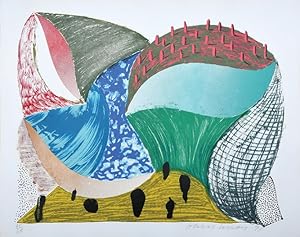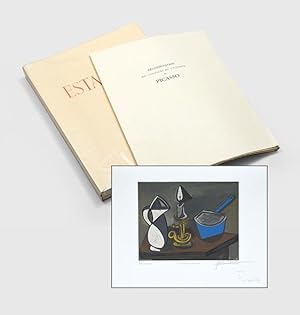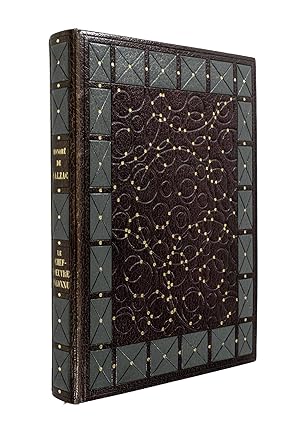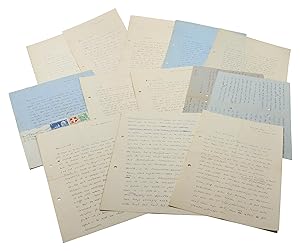l art (Plus de 272 000 résultats)
Type d'article
- Tous les types d'articles
- Livres (254 360)
- Magazines & Périodiques (10 179)
- Bandes dessinées (298)
- Partitions de musique (2 961)
- Art, Affiches et Gravures (2 730)
- Photographies (440)
- Cartes (38)
-
Manuscrits &
Papiers anciens (1 360)
Etat
Reliure
Particularités
- Edition originale (42 874)
- Signé (9 620)
- Jaquette (34 339)
- Avec images (162 043)
- Sans impression à la demande (270 990)
Livraison gratuite
Pays
Evaluation du vendeur
-
Unique Battle Cry Typescript [SIGNED] [WITH] Battle Cry Original Screenplay [WITH] Battle Cry Revised Final Shooting Script [SIGNED, INSCRIBED, WITH 69 ORIGINAL SILVER GELATIN PRINTS]. Five volumes
Edité par NP, NP, 1954
Vendeur : ERIC CHAIM KLINE, BOOKSELLER (ABAA ILAB), Santa Monica, CA, Etats-Unis
Signé
Hardcover. Etat : g to vg. Original document. Originally published in 1953, "Battle Cry" is the enthralling first novel by legendary American author Leon Uris, best known for such classics as "Trinity" and "Exodus." Many of the events in the book are based on the writer's own World War II experience with the 6th Marine Regiment. Original typescript, screenplay and revised final shooting script with many manuscript annotations by Leon Uris: Bound by the "Hollywood Bindrey". - The original typescript of "Battle Cry" is bound in three volumes, in full decorative morocco bindings,with gold lettering to spines. Raised band. Each binding signed E. T. and dated 1973. Decorative endpapers. 800 of a total of 830 leaves have been underlined and / or annotated in pencil (regular and red) by Leon Uris. The three-volume typescript is housed in a matching olive cloth covered slipcase. Volume 1 with fly leaf handsigned by Leon Uris. Maquette of the first five pages bound in. [3], 9, 304 leaves, of which only nine have no annotations nor underlining. Volume 2 with fly leaf handsigned by Leon Uris. [1], 305-608 leaves, of which only thirteen have no annotations nor underlining. Volume 3 with fly leaf handsigned by Leon Uris. [1], 609-816 leaves, of which only eight have no annotations nor underlining. Leaves watermarked "Macadam Bond." "Battle Cry"'s patriotic spirit - "in contrast to war novels by Norman Mailer (The Naked and the Dead), James Jones (From Here to Eternity), Herman Wouk (The Caine Mutiny), Irwin Shaw (The Young Lions), and James Gould Cozzens (The Guard of Honor) - expressed a positive, supportive view of the military despite the carnage, confusions, and loss of life inherent in war. Patriotism not nihilism, heroism, not cowardice, defined its themes, which were welcomed by the marines and the public. All of this made the book a commercial success. Warner Brothers bought the film rights, and Leon Uris moved to Hollywood to write the following screenplay for the movie, which was released in 1955." (See: The New York Times, dated 6/25/2003, and Ira B. Nadel's "Leon Uris: Life of a Best Seller," pp. 52-67). - The original "Battle Cry" screenplay is bound in olive calf, with gold lettering and tooling to spine. Leon Uris' name in gilt to front cover. Raised bands. Marbled endpapers. Binding by Hollywood Art Book Bindery, in Los Angeles. [1], 157 leaves; Nine 8 x 10" original silver gelatin prints depicting behind-the-scene views; [3] leaves (Index to Breakdown), 3 leaves (Set List from Final Script dated 2/13/1954); 120 leaves (Daily Production Call sheets). Title page dated 11/30/1953 and annotated in blue ink by Leon Uris. Leaves 2 and 3 of the cast of characters annotated in pencil and blue ink. Extensive annotations in blue ink and or pencil to leaves 58 to 62, 64 to 67, 69, 71, 72, 76 to 107, 111 to 139, and 140 to 157. Laid in at rear, eight typed Test Scenes: "The Squad" (4 leaves), "Marion and Spanish Joe" (2 leaves), "Ski" (1 leaf), "Pat and Andy" (4 leaves), "Pat and Andy #2" (3 leaves), "Pat and Andy #3" (2 leaves), "Danny and Kathy (Alternate)" (2 leaves), and "Danny and Kathy" (2 leaves). - "Battle Cry - Revised Final" (shooting script) screenplay is bound in olive calf, with gold lettering and tooling to spine. Leon Uris' name in gilt to front cover. Raised bands. Marbled endpapers. As indicated at upper margin of fly leaf at rear, binding by Hollywood Art Book Bindery, in Los Angeles. This revised final screenplay is interspersed with sixty 8 x 10" original silver gelatin prints being movie stills (49) as well as behind-the-scene views (11) housed in plastic leaves bound in. Three photographs have a smaller size (5 3/4 x 8"). Ten of the 60 silver gelatin prints come directly from the Warner Bros Pictures Distributing Corporation, as captioned at lower margin. The title page dated 3/27/1954 is handsigned in light blue ink by the director Raoul Walsh, the assistant director Russ Saunder, production designer John Beckman, and technical adviser Colonel Jim Crowe. Two inserts, being hand-colored maps of Saipan and Red Beach, bound between leaves 125 and 126. The first four leaves of the revised final screenplay are handsigned and inscribed to Leon Uris by ten members of the cast, namely: Tab Hunter (Danny Forrester): "Mr. Uris, I loved the book "Battle Cry" and I only hope that I was able to capture a part of "Danny" in this film. Thanks for everything. My best, Always, Tab Hunter '54," Mona Freeman (Kathy - later Mrs Danny Forrester), Aldo Ray (Pvt. / Pfc Andy Hookens): "Leon - A great novel deserves a great filming, Here's Hoping!", William Campbell (Pvt. 'Ski' Wronski), John Lupton (Pvt. / Cpl. Marion 'Sister Mary' Hotchkiss), Justus E. McQueen (Pvt. L.Q. Jones), James Whitmore (MSgt. Mac / Narrator), Nancy Olson (Mrs. Pat Rogers), Rhys Williams (Enoch Rogers), Hilda Plowright (Mrs. Rogers - Pat's mother). Laid in at rear, a typed and handsigned 3-page letter from Los Angeles-based award-winning freelance journalist David Robb to Leon Uris. In this letter dated December 6, 2002 (six months before Uris' death), David Robb, the author of "Operation Hollywood: How the Pentagon Shapes and Censors the Movies" tells Leon Uris that after searching through 'thousands of pages of Pentagon documents - internal memos and correspondence between military officials and Hollywood producers,' he discovered a file in which the Pentagon had concerns about an aspect of Leon Uris' screenplay, namely, the racial friction depicted between two of the characters, Pedro and Speedy. After telling Uris that he wrote a powerful script that touched on a very sensitive issue, David Robb ends his letter by asking the author of "Battle Cry" the following seven questions: 1) How did you feel about this scene being cut from the movie? Did it bother you, or were you okay with it? 2) Did you fight to keep it in the movie? If so, to whom did you complain? 3) Who made the final decision to edit it out? Raoul Walsh? A studio executive? 4) Was there a real-life pe.
-
Voyage au bout de la nuit
Edité par Paris, Denoël et Steele, [15 octobre] 1932., 1932
Vendeur : LIBRAIRIE HÉRODOTE JEAN-LOUIS CECCARINI, Paris, France
Membre d'association : ILAB
Livre Edition originale
Couverture souple. Etat : Neuf. Edition originale. LE RARISSIME EXEMPLAIRE N° 2 IMPRIMÉ SUR VERGÉ D'ARCHES, LE PREMIER GRAND PAPIER, avant 100 exemplaires imprimés sur papier Alfa. In-8° ; 623 p., 1 feuillet blanc non chiffré. Broché de l' éditeur à l'état neuf, non coupé ! La plus belle condition que l'on puisse espérer pour ce livre (1932). Les rarissimes exemplaires nominatifs du tirage de tête sur papier vergé d' Arche, réservés à quelques proches de l'auteur, sont les plus recherchés. Cette édition originale en premier grand papier compte parmi les plus rares de la littérature du XXe siècle. Le dossier complet avec photographies sur notre site web: librairieherodotecom FIRST EDITION. FIRST LARGE PAPER. VERY SCARCE. FICHE BIBLIOGRAPHIQUE DÉTAILLÉE ET PHOTOGRAPHIES SUR NOTRE SITE : LIBRAIRIEHERODOTE,COM.
-
La Nouvelle Chute de l'Amérique (The New Fall of America).
Edité par Paris: Les Éditions du Solstice, 1992, 1992
Vendeur : Peter Harrington. ABA/ ILAB., London, Royaume-Uni
Edition originale Signé
First edition, first printing, number 24 of 80 copies signed by Lichtenstein and Ginsberg on the limitation page from a total edition of 125; each print is initialled lower right by Lichtenstein, numbered lower left. In 1991, Lichtenstein was approached to provide illustrations for a French edition of Allen Ginsberg's The New Fall of America. Ginsberg selected 11 poems to be translated into French and Lichtenstein created 10 collages inspired by them, from which etchings were printed for the book. The imagery is characteristic of Lichtenstein's work in popular illustrations. "The image of Ginsberg as a Buddha in a lotus pose, for instance, was inspired by a vignette symbolizing meditation on a yoga class sheet. Cubistic visions of the city and emblems of explosions alternate with more peaceful landscapes to provide a visual counterpart to Ginsberg's vivid evocation of contemporary America" (Morgan Library and Museum). Corlett 267-276. Folio. Original red cloth, spine lettered in white, Velin d'Arches paper pages unbound. With the publisher's blue cloth slipcase. 10 coloured etching and aquatints on 250 gsm Velin d'Arches paper. Sheet sizes: Approx 48 x 35.4 cm. Image sizes: Approx 37.5 x 27.8 cm. Fine in fine slipcase.
-
Collection of letters signed to Justin Brierly.
Edité par 4 January 1943 - 26 March 1945, 1945
Vendeur : Peter Harrington. ABA/ ILAB., London, Royaume-Uni
A collection of autograph and typescript letters from a teenage Neal Cassady, Beat icon, and the model for Dean Moriarty in On the Road. The letters were all written to Cassady's friend and mentor, Justin Brierly, a significant number while Cassady was serving a sentence at the Colorado State Reformatory. They are the earliest surviving Cassady letters known, five of which remain unpublished. The archive also likely constitutes the largest such collection in private hands. On the Road opens with the narrator's report of "Dean"'s legendary "jailkid" origins: "First reports of him came to me through Chad King, who'd shown me a few letters from him written in a New Mexico reform school. I was tremendously interested in the letters because they so naively and sweetly asked Chad to teach him all about Nietzsche and all the wonderful intellectual things that Chad knew. At one point Carlo and I talked about the letters and wondered if we would ever meet the strange Dean Moriarty. This is all far back, when Dean was not the way he is today, when he was a young jailkid shrouded in mystery" (Kerouac, p. 1). At turns poignant, vulnerable, defiant, beseeching, grateful, and funny, this exceptional archive of juvenile correspondence sheds light on a pivotal period in Cassady's youth, and Brierly's impact on it. Brierly was a prominent member of Denver society, noted both as a patron of the performing arts in Colorado and for his efforts to place promising young misfits in highly regarded universities. He first met Cassady in 1941, when the rebellious 15-year-old was living with Brierly's uncle. Impressed by his intelligence, Brierly took an active role in Cassady's life over the next few years, helping him get into high school, encouraging and supervising his reading, and finding employment for him. Cassady was introduced in 1946 to Jack Kerouac and Allen Ginsberg by another Brierly protégé, Hal Chase ("Chad King" in On the Road), who Brierly had helped place at Columbia University. Kerouac in turn met Brierly in 1947 during a trip to see Cassady in Denver, and established a friendship with him. In 1950, Brierly wrote an article for the Denver Post about Kerouac's debut novel The Town and the City, and organized a book signing for him in Denver. Kerouac in turn immortalized Brierly as "Denver D. Doll" in On the Road, "Justin G. Mannerly" in Visions of Cody, and "Manley Mannerly" in Book of Dreams. The letters comprise: 1) Autograph letter. Los Angeles, CA. 4 January 1943. Two leaves, rectos and versos, on Gates Hotel letterhead; in pencil; taped together at top left. With typescript copy and clipped return address, in pencil, from mailing envelope. Cassady thanks Brierly for his recent financial assistance, recounting how he had lost the money he previously had: "I think the maid took it. Naturally I am hopping mad, as I don't have a cent, but I can get a train to Salt Lake and hitch hike from there.". 2) Autograph postcard. Los Angeles, CA. 29 May 1943. One leaf, recto and verso; printed postage on recto; in pencil; franked. In this brief note, which he states will be followed by a letter, Cassady tells Brierly that he "arrived here on Fri. afternoon (the 21st), was in jail Sun. afternoon (the 23rd), nice & fast huh?", and of the subsequent negotiations with his parole officer, Paul G. White. 3) Autograph letter. Los Angeles, CA. 3 June 1943. One leaf, recto and verso, on lined notepaper; in pencil; tape residue upper margin. Written from "L. A. County Jail, Tank 13 E2," Cassady's follow-up note to the previous postcard above does not go into greater detail of his arrest - "I have very little to say concerning my last mess up" - but he does add, "I have no excuse for going to jail & this time I shan't speak of my reformation, just watch subsequent events & judge for yourself". He states he has the money to return to Denver, notes several times at which he'll be free to call Brierly, then writes, "Justin, this going back & forth from Colo. to Calif. for the last two years & really accomplishing nothing is, although by my actions it doesn't appear to be, more depressing to me than anything in my life has been," and closes with, "I'll write again soon, & I'm really sorry I've disappointed you". 4) Autograph letter. Los Angeles, CA. 12 January 1944. One leaf, recto and verso, on plain tanned paper; in black ink. Cassady outlines his potential options in the wake of his parole violation and arrest in California, stating, "Well, you know my quandary - if I wasn't in a state of doubt about what to do I wouldn't write anyhow, so let's be for figuring this thing out". He then writes: "You see, I am still obligated to you, altho, now it's not money anymore, but advice. I shouldn't be so dependent on you, however, this is no time for individualism, as you know my problems as well as I, & can answer them much easier. I also shouldn't impose on you like this, but I excuse my selfishness & disregard for how busy you are, by saying you like to help people out & besides, I can't lose anything by asking him. Now that I've asked, I expect you to answer directly, none of this 'use your own judgement [sic], Neal,' or else 'now I don't know, but maybe this is best, or maybe that is best for you.' I want you to think it over 'till [sic] you know which is best for me. Maybe you don't have to think it over, you may just say, 'see the judge' or 'join the Navy.' I don't care, just solve it for me. It's your baby now". 5) Autograph letter. [Los Angeles, CA]. 17 March 1944. Three leaves, rectos only, on lined paper; in pencil; tape residue to upper margins. Cassady begins the letter with, "You have probably received [sic] my other letter by now. So no need to tell you I'm in jail charged with escape". He continues on the next page, "The plan I have in mind for my defense is; 1, to point out my psychological reason for leaving camp; 2, lack of any criminal tendencies since then; 3, reaction of freedom after reading White's le.
-
Two albums with 247 photographs, 1 postcard, and 4 building plans from the archaeological site of Aphrodisias.
Edité par [Aphrodisias, 1904-1905]., 1905
Vendeur : Antiquariat INLIBRIS Gilhofer Nfg. GmbH, Vienna, A, Autriche
45,5 x 36 cm (albums) and various formats (photographs and plans). Extensive documentation of the first official archaeological excavation of Aphrodisias in the historic Caria region, now part of Anatolia, Turkey. The first album contains 199 photographs and the valuable plans, captioned "theatre", "quarries" (with parts of the city), "thermae", and "temple of Aphrodite converted to a Byzantine church; state of the ruins in 1904, indication of the digs". The dating of the album to the first campaign of 1904 suggests that the second album (48 photographs and the postcard) shows the excavations of 1905. The smaller extent of this album agrees well with the fact that Gaudin left Aphrodisias soon after the beginning of the campaign. - Named Aphrodisias in the Hellenistic period, the city gained importance since the 1st century AD as an early and reliable ally of the Roman Empire in the region. During the Roman period, Aphrodisias enjoyed extensive privileges and rose to become a provincial capital. The well-preserved ruins of public and private buildings excavated since 1904 bear witness to the wealth and importance of Aphrodisias during Imperial times. The city was also a centre of marble production and sculpture, adding greatly to its archaeological significance as documented in the albums. In the early 7th century, an earthquake largely destroyed the now Byzantine city that had been renamed Stauropolis around the same time, in an effort to remove pagan connotations. Little remained of Aphrodisias's former importance and splendour thereafter. - Osman Hamdi Bey, the father of Turkish archaeology, had first visited the site of Aphrodisias in 1892 and obtained permission for excavations in 1898. Lacking the necessary funds for a large archaeological campaign, the Francophile Hamdi Bey proposed to Paul Gaudin, then director of the Smyrna-Cassaba railway, to organize excavations in Aphrodisias under his license. A passionate amateur archaeologist who had already led excavations in the bronze-age necropolis of Yortan, Gaudin financed the initial campaign in August 1904. The summer of 1905 saw a more professional campaign under the scientific direction of the French archaeologist Gustave Mendel (1873-1938), with moderate financial support from the French state and private institutions. In August 1905, Paul Gaudin was called to Damascus to serve as director of the Hejaz railway project and therefore was absent for most of the 1905 campaign. Due to a conflict between Gaudin and Mendel the excavations did not continue after 1905, and it was only in 1962 that Kenan Erim began a new campaign under the aegis of New York University that is currently led by Professor R. R. R. Smith (Oxford). - In view of the long interruption of work, Gaudin's photographic documentation is particularly valuable, as many of the archaeological findings have been dispersed among museums in Turkey and Western Europe or even lost over time. As Gaudin's 1904 campaign was not conducted systematically, the earlier photographs provide particularly valuable information concerning the progress of the excavations. - Paul Gaudin was born in Paris, the son of the chemist Marc-Antoine Gaudin (1804-80). His passion for photography was certainly inherited from his pioneering father who in 1841 introduced the usage of bromine fumes to improve the sensitivity of the plates, which allowed for a great reduction of the necessary exposure time and published the first French journal devoted to photographic research, "La Lumière". In 1880, Paul Gaudin completed his engineering training, obtained a position as deputy stationmaster in Paris, and was subsequently employed as an inspector by the Chemins de fer de l'Ouest. His career took an unexpected turn when he was sent to Turkey in 1892 to direct the Moudania-Brousse railroad line operated by the important Belgian investor and engineer Georges Nagelmackers. As early as 1894, after Nagelmackers had obtained the concession for the Smyrna-Cassaba railway, Gaudin was promoted to director of this important line and led its expansions. Paul Gaudin's lasting contributions to archaeology with his excavations in the Yortan necropolis (1898 and 1901) and in Aphrosidias, as well as his important collection of Smyrnian figurines and other objects, date to his time in Smyrna (Izmir). Gaudin's most prestigious and challenging position as a railroad engineer, however, was his charge by Sultan Abdul Hamid II to complete the famous Hejaz railway. Despite financial problems, difficult geographical and climatic conditions, and the often hostile (sometimes even violent) reaction of the local population, Gaudin led the rapid expansion of the line from Ma'an to Medina, where the construction came to a definite halt in 1908. During this project, Gaudin was the first to photographically document the Arabic old town of Al-'Ula in 1907. - Little is known of Paul Gaudin's employments after his contract with the Hejaz railway expired in 1909. He briefly collaborated on the disastrous Ottoman project for the construction of a railway line from Hodeidah to Sana'a in 1911 and seems later to have permanently returned to France, where he died in Versailles in 1921. Today, Paul Gaudin is best remembered as a major patron of the Louvre, to which he donated more than 2,000 artifacts from his collection. The Istanbul Museum, the British Museum, and other institutions also owe him important contributions to their Asia Minor, especially Smyrna, antique collections. - Collection of Paul Gaudin, family inheritance. - G. Charloux, Paul Gaudin et les premières campagnes de fouilles à Yortan et à Aphrodisias, in: Orient-Express, no. 1, 2001, pp. 24-26; M. Collignon, Note sur les fouilles exécutées à Aphrodisias par M. Paul Gaudin, in: CRAI, 48/6, 1904, pp. 703-711; A. Le Goff/N. Coutsinax, Les dossiers individuels de mission conservés aux Archives nationales et leur apport à l histoire de l archéologie: l exemple de la fouille d Aphrodisi.
-
[La Divina Commedia / The Divine Comedy - Manoscritto dell'inizio del XX secolo della Divina Commedia di Dante - con strofe manoscritte da "L'Inferno / Inferno" - "Purgatorio" - "Il Paradiso / Paradiso"] - The Manuscript is titled: "Pictures Illustrating The Pilgrimage of the Divine Poet Through The Realms of Punishment of Penance and Peace" - Illuminated Devotional Manuscript of section of "L'Inferno / Inferno" - "Purgatorio" - "Il Paradiso / Paradiso" - with excerpts of Dante's Divina Comedia, in the style of medieval illuminated manuscripts. The manuscript is a strictly themed Dante Devotion and is of magical quality if one considers the fantastic, original calligraphy artwork, the composition of the manuscript and the coded meaning to the composer of this manuscript. The Folio - size manuscript is massive and has 216 pages, of which 109 pages are with illuminated, original watercolour-paintings in the style of the medieval masters, sometimes collages with watercolour and original e
Edité par England, [Douglas Cockerell / John William North], no year [c.]., 1910
Vendeur : Inanna Rare Books Ltd., Skibbereen, CORK, Irlande
Livre Signé
Folio (34 cm wide x 42.5 cm high). 216 pages. Hardcover / Binding in full green morocco with lettering and Dante's head as bronze sculpture per inlet to front cover. Binding by Douglas Cockerell, signed "WHS", during his directorship of W.H.Smith & Son (1905 - 1914). The manuscript is on excellent paper, watermarked O.W.P. & A.C.L. [O.W. Paper & Arts Co. Ltd., established by English painter John William North (1842-1924) in 1895]. The binding rubbed and with some small damages, in need of some minor restoration but overall still very good. The interior, the paper and the artwork all in excellent condition besides one of the juxtaposed photographs (Filippina Lippo) removed from the manuscript with some residue of the photograph remaining and some of the photographs with some dogears and minimal discoloration. All the original artwork in spectacular and fresh condition. The manuscript is a spectacular find and the quality of its execution is of utmost interest for any lover of rare books, manuscripts and special bindings. The circle of Douglas Cockerell, his involvement in one of the most beautiful books ever printed: the Ashendene Press Dante, as well as Cockerell being the binder of this unique manuscript, the fantastic paper used for the manuscript by one of the idyllist movement's central figures, John William North, and the wonderful Dante - theme of the manuscript with illuminated poetry from the Divine Comedy and the unique style of collage art, lets us rightfully dream that the anonymous composer of the manuscript was an important or at least peripheral member to either the Arts and Crafts Movement, the Ashendene Press or it was someone who worked in the style of the calligraphy schools that were inspired by William Morris or even earlier epigones like Owen Jones. Sprache: english.
-
The original artwork for Kaléidoscope: ornements abstraits. Together with a set of the published pochoir plates.
Edité par Paris: Éditions Albert Lévy, [1923-26], 1923
Vendeur : Peter Harrington. ABA/ ILAB., London, Royaume-Uni
The original, highly finished artwork for the complete suite of pochoirs for the Verneuils' Kaléidoscope, "a masterwork of Art Deco design" (V&A website "The Kaleidoscopic Wonder of Art Deco Prints"). A visually spectacular document of what is widely recognized as one of the most brilliant of the art deco pattern books - a genre which Ray considered displayed art deco "in its purest form" (The Art Deco Book in France, p. 28) - a group remarkable for its artistry and almost equally for having survived close to a century complete. We have been unable to find records for any comparable archives on the market. The 20 sheets of Kaléidoscope contain 87 textile designs composed of "colourful, abstract motifs, which evoke, with their fragmented vocabulary, the dynamism of modern culture" (The Met web site) which were to exert a strong influence on the spread of art deco, becoming something of a toy box for designers for decades to come. Maurice Verneuil (1869-1942) began his artistic education in 1888, enrolling in the architectural section at the École nationale supérieure des beaux-arts in Paris. However, he was beguiled by the growing interest in ornament, and in 1892 joined the École Guérin where he fell under the influence of Eugène Grasset, one of the pioneers of art nouveau. Subsequently Verneuil became a skilful, mostly self-taught practitioner in a wide range of artistic disciplines - posters, furniture, marquetry, enamel, ceramics, batik, embroidery, photography and painting - and a leading theoretician of modern design in France, contributing illustrations and articles to Grasset's Art & Decoration and Albert Quantin's Le Monde moderne. In 1925 he was responsible for the publication of Étoffes et Tapis Étrangers, an illustrated study of the textiles exhibited at the Exposition Internationale des Arts Décoratifs et Industriels Moderne, one of the key publications of the exhibition that gave birth to the art deco movement. The work is credited on the title page to Maurice and "Ad. Verneuil", and it has been suggested that this refers to Adam, Maurice's brother. However his collaborator on this key project was in fact his wife Adélaïde, an attribution finally confirmed by Maurice's biographer Helen Bieri (Bieri, p.118). Adélaïde Verneuil de Marval (1898-1998), a Swiss artist, illustrator, bookbinder, and art critic, married Maurice in 1921, having been fascinated by his theories of design. By way of a honeymoon they made an extensive tour of Asia, bringing back a collection of prints and artefacts which was to influence their work thereafter, and from which Adélaïde donated a number of pieces to the Musée ethnographique de Genève. She is probably best known in her own right as a book illustrator, with a speciality in books on Buddhist themes. Much has been made of the fruitful convergence of the art deco period and the flowering of the pochoir technique, praised by Ray for its "subtle gradation" of colours. These original drafts reveal something of the process behind the creation of the Verneuils' innovative designs. Pencil annotations show that the plate order was changed for publication and at least two of the plates were printed inverted according to the original markings, and entire sections of two plates have been excised and neatly replaced with a new pattern. Overall the palette of the pochoirs shifts towards lighter, cooler tones, the colours of the gouaches are denser, more intense, and inevitably the line is tougher and more vigourous, the surface actively worked; these originals possess great presence. A perhaps unique opportunity to own the original artwork for one of the true masterpieces of the art deco era. Helen Bieri, Maurice Pillard-Verneuil: artiste décorateur de l'Art nouveau, 1869-1942, 2000; Deasy, "The Kaleidoscopic Wonder of Art Deco Prints", V & A web site, retrieved 13/12/2019); Ray, The Art Deco Book in France; Robinson, "Splendeurs de l'Art Deco"; Schneider-Henn, Ornament und Dekoration, 448 (wrongly identifying "Ad." Verneuil). 20 original designs, gouache over pencil on heavy paper stock (c. 440 x 345 mm), pencilled editorial annotations and alterations to the margins, two plates with carefully excised sections replaced with corrected designs, loosely corner mounted into recent window mounts for handling and display; with the published suite, title page and 20 pochoir plates executed by Jean Saudé, many - as in the originals - utilising metallics, without the original chemise. The two housed in a custom cream silk moiré solander case, illustration from the front panel of the original binding mounted on the lid. Paper lightly browned, a little more so at the margins, light soiling and few paint smudges, most sheets with some pinholes, occasional minimal chipping to the corners; some paint surfaces with mild flaking, otherwise in very good, unrestored condition.
-
Collection of 39 autograph letters signed, in French, to the Art critic Vittorio Pica, comprising 13 letters and 26 cards.
Edité par , 1898 1926., 1926
Vendeur : Kotte Autographs GmbH, Roßhaupten, Allemagne
Manuscrit / Papier ancien
74 pages (48 pages Small 4to and 8vo and 26 pages 12mo). 15 autograph envelopes. An important and unpublished archive of letters from James Ensor to Vittorio Pica. Vittorio Pica was an influential Italian art critic and one of the earliest defenders of Modernism in painting. This correspondence, spanning more than 20 years, covers a large part of James Ensor key artistic development including his intense study of the effects of light (inspired by the Flemish Old Masters). His lack of affiliation with any existing artistic movements, as well as the public s and contemporary artists lack of interest in his art, are made clear in the first part of the correspondence (1898-1899). He asks Pica repeatedly to write an article about him in the Emporium, an important and influential art review. He describes articles written by Maeterlinck, Verhaeren, Demolder for La Plume (the letter to Léon Deschamps is about this article and an exhibition in Paris) and La Libre critique, and sends Pica etchings to show him recent work. In several letters Ensor asks Pica to act as his agent and contact museums in Italy, especially in Venice and Naples. After two years of correspondence, Pica has still not written his promised article on Ensor. In April 1899, Ensor speculates that there may be a plot against him: "Mes ex-imitateurs devenus logiquement mes ennemis acharnes ont certes, par leur malveillance et critiques concertes retardes longtemps mon succès ( ) Votre silence me parait anormal." He complains that the etchings Pica has are too old to be representative of his art. In December 1899, he writes that he has learned about the publication of Pica s next book, À Travers les Albums et les Cartons, in which he hopes Pica will discuss his art. He proposes to send Pica photographs or etchings of important paintings such as Le Lampiste, Entrée du Christ à Bruxelles, and Mardi Gras 1889. He gives Pica information about the Belgian artistic scene, exhibitions, artists he respects. In his letter of 12 March 1900, he writes as post-script a very interesting and important "study" of Belgian/Flemish art and artists and art critics as compared to classical French 19th-century painters: "PS: L exposition la Libre Esthétique est ouverte à Bruxelles. La critique belge défend passionnément tous les artistes considérés à tort ou à raison comme artiste flamands et par contre juge très sévèrement les artistes novateurs. C est là une erreur manifeste car depuis Brueghel et Rubens, l art flamand est bien mort. L art flamand ou plutôt belge est composé depuis 1830 de reflets et d ombres. Nos bons peintres belges descendent de l étranger, il faut bien le reconnaitre. Descendant de Courbet: Louis Dubois, H. Boulenger, Alfred Verhaeren, enfin tous les paysagistes belges sans excepter les très récents Courtens, Gilsould, etc, etc. Descendant de David, peintre révolutionnaire: Navez, de Keyser, Wappers, de Bieve, Wiertz même, admirateur de Rubens mais peintre académique et très piètre coloriste ( ) Descendant de Manet: tous les Impressionnistes belge. Emules de Signac: Theo van Rysselberghe. Héritier de Bastien Lepage, Burns Jones, Holbein, Kate Greenaway: Fernand Khnopff. Sorte de Watteau courbétisé: Alfred Steven ( ) Seul Eugène Delacroix le plus Rubénien des peintres français n a pas eu un reflet en Belgique. Indice significatif. Le flamand n est plus coloriste. L art flamand est mort, bien mort, alors pourquoi ressusciter ce grand cadavre ( )".In May 1900, Pica s study of Ensor is finally published in the journal Minerva. After publication of the critical piece in Minerva, the tone of the letters changes. From "Dear Mr. Pica," Ensor switches to "My dear Pica." The letters becomes more personal; and as he becomes more confident, Ensor reveals more of his philosophy of art. The letter of 17 November 1902 is, for this reason, quite interesting: Ensor discusses a drawing which he has sent to Pica, Guirlande fantastique, which he fears is "too odd." He depicts in this drawing "une humanité grotesque et débridée confinant à la mascarade, évoluant dans un mauvais jour et enguirlandant de monstruosité la mélancolique figure d artiste personnifiant l oiseau de la sagesse ou d exception," appropriating for himself the figure of the under-rated artist as a bird used by Baudelaire in the famous poem L Albatros. "Je représente volontiers la triste humanité s abandonnant à ses mauvais ou grotesque instincts et ma devise est Peste dessous, Peste dessus, Peste partout (Plague below, Plague above, Plague everywhere). Certes, c est là la règle et j ai toujours trouvé partout fourberie, mensonge et dissimulation et j ai toujours vu ramper devant le fort et écraser le faible. Triste humanité baignée de limon, cette situation ne peut échapper à l artiste sensible et clairvoyant et voit influencer ses sujets. ( ) Je suis fier d être considéré en artiste d exception et souhaite pouvoir planer au-dessus des coutumières turpitudes et les cingler sans merci du crayon et de la pointe. J en appelle aux vieux humouristes mais cette race de grands hommes libres serait-elle éteinte et nos artistes modernes semblent rester indifférents devant les pires turpitudes. ( ) Il m est permis de peindre et graver pendant les jours insuffisants et sans soleil de l hiver, triste saison inspiratrice de mélancolie où dans les climats du nord la maladie et les ténèbres règnent en souverains et où la mort fauche impitoyablement parmi les gaités forcées des carnavals factices." He then pays respect to his friend Pica,one of the rare critics who understood his art when he was criticized by everyone in the Belgian art world.He begins taking advice from Pica and agrees to retouch a drawing he offered to Pica. He wants to hear Pica s feelings about his paintings and remarks on how they were described by Belgian critics: "Etes-vous satisfait du coloris et clarté et de l enveloppe d air et de la personnalité de la vision?". He is bitter about the reception of his art and explain.
-
ULYSSES
Edité par Shakespeare and Company May 1927, Paris, 1927
Vendeur : Phillip J. Pirages Rare Books (ABAA), McMinnville, OR, Etats-Unis
Edition originale Signé
Ninth Printing of the First Edition. 205 x 160 mm. (8 1/8 x 6 1/4"). 4 p.l. (first blank), 735 pp. DRAMATIC DARK BLUE-GRAY CRUSHED MOROCCO, BLIND-TOOLED AND INLAID TO AN ABSTRACT DESIGN, BY SALLY LOU SMITH (stamp-signed with her initials in gilt on rear doublure), with overall wraparound design of inlaid elongated, irregular-shaped pieces of black, gray, blue, tan, and yellow morocco with blind-tooled lines extending from these shapes, MATCHING MOROCCO DOUBLURES tooled in gilt with branch-like lines, yellow handmade free endpapers, gray flyleaves, all edges gilt. In the matching morocco-backed clamshell box. Front flyleaf INSCRIBED BY JOYCE TO H. G. WELLS: "To / H. G. Wells / Respectfully / James Joyce / 5 November 1928 / Paris." Slocum and Cahoon 17. â Isolated faint foxing or marginal spots, but a clean, fresh copy with few signs of use, in a new binding. This later printing of what is generally recognized to be the most important 20th century novel in English is inscribed by the author to one of his earliest and most important supporters, and is offered in a binding by an influential Designer Bookbinder. First issued in 1922, "Ulysses" rocked the literary world. J. B. Priestley, writing in the "Clarion" in 1934, said what most scholars and critics acknowledge--that "as a literary feat, an example of virtuosity in narration and language, it is an astounding creation. Nobody who knows anything about writing can read the book and deny its author, not merely talent, but sheer genius." Our copy was presented by Joyce to H. G. Wells (1866-1946), whose support of "Portrait of the Artist as a Young Man" was instrumental in establishing Joyce's literary reputation. Reviewing that book in 1916, Wells praised "its quintessential and unfailing reality. One believes in Stephen Dedalus as one believes in few characters in fiction." He considered "Portrait" to be "by far the most living and convincing picture that exists of an Irish Catholic upbringing," and noted how sharply it contrasted the Irish and the English: "No single book has ever shown how different they are, as completely as this most memorable novel." The two men did not meet until 12 years later, in Paris, at which time Joyce inscribed the present copy of his masterwork to Wells. At the same time, Joyce presented Wells with some excerpts of what would become "Finnegan's Wake." On 23 November 1928, Wells wrote to Joyce from his winter home in the south of France, expressing his regret that he could not promote these latest works with the same enthusiasm: "I have enormous respect for your genius dating from your earliest books and I feel now a great personal liking for you but you and I are set upon absolutely different courses. . . . I want a language and statement as simple and clear as possible. . . . Who the hell is this Joyce who demands so many waking hours of the few thousand I have still to live for a proper appreciation of his quirks and fancies and flashes of rendering?" Still, Wells acknowledged, "Your work is an extraordinary experiment and I would go out of my way to save it from destructive or restrictive interruption." The abstract binding by distinguished modern artisan Sally Lou Smith evokes a journey: as the multicolored inlays march from the rear edge around the spine and across the front against a grim, gray ground, Bloom's peregrinations through Dublin and the characters he encounters seem to be brought to mind. Born in the United States, Smith (1925-2007) spent several years in France, then settled in 1958 in London. There, she spent four and a half years learning bookbinding under John Corderoy at Camberwell School of Arts & Crafts before beginning to work out of her own bindery in 1963. Her work has been widely honored both in her early days (she won the bookbinding award given by Major J. R. Abbey in 1965) and for many years since (among others, she won three Thomas Harrison Competition prizes). In the catalogue for the "Modern British Bookbinding" exhibit held in Brussels and The Hague in 1985, five of the 50 bindings pictured were executed by Smith, who is listed in the catalogue as one of the 20 Fellows of Designer Bookbinders, the principal bookbinding society in Great Britain. She served as president of that society and was a greatly respected teacher of bookbinding. A comprehensive survey of her work appeared in "The New Bookbinder" no. 21 (2001).
-
En attendant Godot. Pièce en deux actes.
Edité par Paris: Les Éditions de Minuit, 1952, 1952
Vendeur : Peter Harrington. ABA/ ILAB., London, Royaume-Uni
Edition originale
True first edition, first printing, number 19 of 35 copies on vélin supérieur, here with the original wrappers bound into a particularly elegant binding by Pierre Lucien Martin, one of the best respected French binders of the century. This is only the second copy we have handled. The original French text was composed between 9 October 1948 and 29 January 1949, although the full theatrical premiere was not until 5 January 1953, at the Théâtre de Babylone, Paris. Beckett's translation into English, Waiting for Godot, premiered in London in 1955 and was published that same year. Federman & Fletcher 259. Octavo. Finely bound in blue morocco by P. L. Martin (184 x 115 mm), with the original wrappers bound in, spine and sides decorated in gilt and blue, spine lettered in gilt direct, blue endpapers, all edges gilt. In matching slipcase, morocco entry with blue paper sides. A fine copy inside and out.
-
Si je mourais là-bas.
Edité par Paris Louis Brodeur, 1962
Vendeur : Shapero Rare Books, London, Royaume-Uni
Livre Signé
Limited edition, one of 40 copies on vélin pur chiffon from a total edition of 180 copies; folio (48 x 38 cm); 61 pp. text, 37 woodcuts (2 double page and 7 within text, 30 in colour) including duplicate suite of 18 woodcuts each numbered 21/40 and signed by Braque, one extra plate in triplicate; full black polished calf by P.-L. Martin with abstract geometric design onlaid in brown and cream calf dated 1964 (binder's mark and date), spine lettered in gilt, all edges gilt, suede endpapers, black calf-backed chemise, brown cloth boards, housed in matching slipcase; slight wear to upper edges of spine, very minor scuff to design. Published in 1962, just a year before Braque died, the timely Si je mourais là-bas [If I die over there] was a suite of eighteen wood-engravings to accompany poems from Guillaume Apollinaire's Poèmes à Lou, which Braque himself selected and edited accordingly. Braque had been a close companion of Apollinaire, who died forty years prior to the series but gave a lot of good publicity to Braque and his fellow Cubists. Despite this, Braque felt that his friend, who was also an art critic, understood nothing about painting, a source of playful tension between the pair which may have contributed to the obscure nature of the suite's images. Pierre-Lucien Martin (1913-85) was one of the most successful French binders of the 20th century. He was trained at the École Estiènne in Paris and gained experience in several binderies before emerging as a designer in his own right after the Second World War. His designs are characterised by understated colour, impressive three-dimensional effects, and the intricate but highly logical application of geometry. This volume is a superb example of his work.
-
Pas de couverture. Etat : Bon. Dali_Salvador (illustrateur). "1954. Pas de couverture, . EXCEPTIONNELLE ARCHIVE concernantla gene?se d un chef d uvre de Salvador Dali?, E?tude paranoi?aque-critique de La Dentellie?re de Vermeer, conserve? au muse?e Guggenheim de New York. IMPORTANTE PROVENANCE :toutes les pièces présentées proviennent des archives de Magdeleine Hours, amie de Salvador Dali? et directrice du Laboratoire du musée du Louvre grâce à qui Dali? put effectuer sa "copie" de La Dentellière de Vermeer. Comprend : La palette signe?e de Dali?, seul vestige en couleurs de la premie?re e?tape de L E?tude-paranoi?aque critique de La Dentellie?re de Vermeer. Les palettes de Dali? sont de toute rarete? Selon Nicolas Descharnes, on ne connai?t que 7 autres palettes sur bois dont seules 5 sont signe?es. La palette que nous pre?sentons est par ailleurs la seule d entre elles a? avoir e?te? utilise?e dans le cadre d un projet de performance ; Un double te?moignage photographique, en partie inédit, documentant une performance de Salvador Dali? réalisée au musée du Louvre : 5 grands formats de Robert Descharnes annotés au dos par Magdeleine Hours, et 35 photos inédites prises par les membres du Laboratoire du musée du Louvre. Un grand dessin autographe signésur une double page - contenu dans l'exemplaire de Magdeleine Hours de La vie secrète de Salvador Dalí photo, correspondance et envoi autographe témoignant d'une amitié et d'une collaboration féconde entre Magdeleine Hours et Salvador Dali? Les pièces originales de Dalí que nous présentons sont enregistrées dans les archives de Nicolas Descharnes - l'expert attitré de Salvador Dali (les références seront communiquées à l'acheteur). Un certificat d authenticité pourra être obtenu auprès de celui-ci à la charge de l acquéreur. Un catalogue présentant l'archive est consultable sur notre site ;une version contenant le détail des pièces est disponible sur demande. PROVENANCE Historienne de l art, épigraphiste et archéologue, Magdeleine Hours rejoint en 1933 le laboratoire du musée du Louvre, premier organe officiel consacré à l analyse scientifique des tableaux. Elle prend sa direction en 1946. Sa contribution au succès du projet est inestimable : elle étend le champ d expertise du laboratoire des tableaux aux vestiges archéologiques, met en place des partenariats avec d autres structures scientifiques, et surtout fait connaître ses travaux à travers une série d expositions. Leur succès est tel que leur mode de présentation - où documents scientifiques confrontent l oeuvre originale est systématisé. Par l intermédiaire de Montserrat Dalí et de son époux Camillo Bas, Madgeleine Hours fait à Cadaquès l acquisition d une propriété ayant appartenu à Anna-Maria Dalí, soeur de l artiste. Elle rencontre Salvador Dalí en juillet 1954 et se lie d'amitié avec lui. Magdeleine Hours mettra à sa disposition pour copie La Dentellière de Vermeer, conservée au Musée du Louvre. À la demande de son ami, elle effectuera également des analyses radiographiques sur l'Angélus de Millet : ses découvertes l'aideront à soutenir la thèse paranoïaque-critique qu'il expose dans Le Mythe tragique de l Angélus de Millet (1963) AUTOUR DE L'ÉTUDE PARANOÏAQUE-CRITIQUE DE LA DENTELLIÈRE DE VERMEER La Dentellie?re de Vermeer figure en bonne place dans les cortège des images "Dali?niennes" qui constituent le court-me?trage Un chien andalou (1929), re?alise? en collaboration avec Luis Bun?uel. Invoque?e de?s les premie?res anne?es de sa "conversion surre?aliste", elle accompagne Dali? dans un projet d envergure, L Aventure prodigieuse de la Dentellie?re et du rhinoce?ros, qui l occupera de 1954 a? 1961, alors qu il e?largit le champ des applications de sa "me?thode paranoi?aque-critique". Mêlant peinture, cine?ma, photographie et performance, cette uvre totale est amorce?e en de?cembre 1954, lorsque Dali? annonce son de?sir de re?aliser une copie de La Dentellie?re. Il fait appel a? son amie Magdeleine Hours, directrice du laboratoire du muse?e du Louvre, qui consent a? mettre la.
-
Large folio-size collection (546x360 mm) comprising a four-leaf booklet and complete set of thirty etchings with aquatint set in mats. The title-page includes a heliogravure portrait by Fantin-Latour; introduction and index by Théodore Duret. Edition of 100 copies. In original tan cloth portfolio case. Sheets with full margins, 445x312 mm; plates ranging in size. Printed on paper with the Van Gelder watermark or with crowned lily and monogram 'JGL'. In the lower right margin of each sheet is a small red editorial stamp with numbering of the plates. Good impressions, neatly inked and very fresh, in a perfect condition.Exceedingly rare complete set of etchings with aquatint by the famous French artist édouard Manet, the eldest son of an official in the French Ministry of Justice and a visionary Realist with a profound impact on Modern Art. Printed in Paris by the Swiss-born art dealer, publisher, and collector Alfred Strölin, the etchings are accompanied with an introduction and index by the French journalist, author, and art critic Théodore Duret, one of Manet's greatest champions, and a heliogravure portrait of Manet by Henri Fantin-Latour, an extraction from the latter's celebrated canvas, Hommage à Delacroix, which was exhibited at the Salon in 1864. The early 1860s was a particularly fruitful time in Manet's career specifically and printmaking generally. As Duret explains, this was when the artist was most fascinated with Spanish themes, taking as his subjects the various singing and dancing troops that made their way into Parisian entertainment. In 1861, as a young artist of only twenty-nine years, Manet received honourable mention at the tremendously important Paris Salon with Le Guitarrero ('The Spanish Singer') followed by great notoriety at the 1863 Salon des Refusés with the scandalous Déjeuner sur l'herbe, a reputation perhaps most solidified when his Olympia was shown in 1865. In the same years, the 'Etching Revival' – a period from about 1850 to 1930 when the medium was re-embraced by artists, particularly in France, England, and the United States – was gaining speed thanks to the establishment of the Société des Aquafortistes in 1862. The Society, which aimed to promote etching among artists and the public alike, was established at the urging of the skilled etcher Alphonse Legros. As with other painters, Manet joined the Society new to the graphic arts, and it was Legros who taught him the ropes. Fittingly, among his earliest efforts counts an etching of Le Guitarrero, included here in its final state – a poetic testament to Manet's artistic and technical maturation. Between 1860 and 1882, Manet produced about 100 prints (etchings and lithographs); although a number of these were included in Society-related projects, many others were published posthumously. Upon the artist's death in 1883, thirty etched plates were counted among his possessions, which then became the property of his wife, Suzanne; in 1890, Suzanne printed about thirty impressions of twenty-three of these (including thirteen which had previously been unpublished) at Gennevilliers, where Manet had summered at his family's house. These twenty-three plates, along with seven more, were then ceded to the dealer and printer Louis Dumont who likewise published thirty impressions of each of the thirty plates. As Dumont's successor, the plates then passed into the hands of Alfred Strölin, who is responsible for the current edition, of which 100 copies were printed. Apart from contemporary impressions known in only a small number of copies, the plates of the Strölin edition are generally considered most desirable, as those of previous editions are often poorly inked. There is, however, an additional measure of finality at play: upon completing the print run, Strölin destroyed all the coppers by punching holes in them, thus ensuring his would be the final prints pulled from Manet's plates. The beautiful impressions included in Strölin's edit. Book.
-
Mottram cottage" Original Pen and Ink Drawing
Date d'édition : 1960
Vendeur : rareandsigned, LEEDS, Royaume-Uni
Signé
Signed. Original hand signed L S Lowry "Mottram cottage" Original Pen and Ink drawing ". Exhibited at Stalybridge in 1983 following purchase from the artist's estate in 1981. A truly wonderful very rare pen and ink drawing by Lowry. An original a cottae from Lowry's home town of Mottram. Pen and ink on paper, signed and dated to lower left, L. S. Lowry 1960. "Collintree Cottage" written by artist to top right corner with additional writing "July 1st" to top left corner and "Mottram" to lower right.by the artist. A unique study, seldom seen in such fine detail in the pen and ink medium. An exceptionally scarce original L S Lowry drawing authenticated and sold by Sotherbys Auctions of London, July 1998. The large drawn page is approx 375mm x 265mm. A unique signed Lowry personal drawing which would look incredible framed and mounted. The page has minor signs of creasing with edge fray to the top. Overall the piece is in superb condition for the age. Signed Lowry original art like this is seldom found. This is 100% authentic with an original letter of authenticity. Genuine L S Lowry signed original drawing. Buy your genuine signed L S Lowry originals and signed Lowry drawings and artwork and Lowry autographs from the home of L. S. Lowry originals and the no.1 memorabilia experts here at RARE AND SIGNED. Highly collectable and a surefired investment. Signed by Illustrator.
-
Actes du IVe congrès panafricain de préhistoire et de l'étude du quaternaire.
Edité par Tervuren Musée Royale de l'Afrique Centrale, 1962
4°. 373 S. (und Tafeln); 505 (und Tafeln). Mit Abbildungen, Skizzen und Tabellen. Bibliothekseinbände, Leinen. 3 Sektionen in 2 Bänden. (I) Etienne-A. Bernard. Interprétation astronomique des pluviaux et interpluviaux du Quaternaire africain. - G. Mortelmans et R. Monteyne. Le Quaternaire du Congo occidental et sa chronologie. - Karl W. Butzer. The Pleistocene sequence in Egypt and its implication for pluvial-glacial correlation in the Sahara. - Geoffrey Bond. Pleistocene Research in Southern Rhodesia. - J. D. Clark. Vegetation Patterns, Climate and Sands in North East Angola. - V. L. Bosazza. The Kalahari System with particular reference to its occurence on the Macondes Plateau, Northern Mozambique. - Th. Monod. Notes sur le Quaternaire de la région Tazazmout-El Beyyed (Adrar de Mauritanie). - C. Voute. Geological and morphological evolution of the Niger and Benue Valleys. - W. W. Bishop. A summary of the present position regarding Quaternary stratigraphical research in Uganda. - J. de Heinzelin. Les formations du Western Rift et de la cuvette congolaise. - W. W. Bishop. Pleistocene Correlation in the Uganda Section of the Albert-Edward Rift Valley. - C. Arambourg. Etat actuel des recherches sur le Quaternaire en Afrique du Nord. - Raymond Mauny. Plages soulevées de la région de Nouakchott-Sbkha de Ndghamcha. - O. Davies. The Raised Beaches of Angola and South-West Africa. - Lereno Barradas. On the Need of a Terminology for Quaternary Transgressions and Regressions in Southern Africa. - Y. Coppens. Deux Gisements de Vertébrés Villafranchiens au Tchad. - (II) Raymond A. Dart. The most complete Australopithecus Skull from the Pink Breccia at Makapansgat. - Philip V. Tobias. A Re-Examination of the Kanam Mandible. - L.S.B. Leakey. Remains of Man with Oldowan culture at Olduvai. - R. Trevor-Jones. Skeletal Remains from Salisbury, Southern Rhodesia. - (III) M.-H. Alimen et J. Chavaillon. Position stratigraphique et évolution de la Pebble Culture au Sahara nord-occidental. - R.A. Dart. The continuity and originality of Australopithecine Osteodontokeratic Culture. - F. Clark Howell, G.H. Cole, M.R. Kleindienst. Isimila. An Acheulian occupation site in the Iringa Highlands, SOthern Highlands Province, Tanganyika. - M. R. Kleindienst. Components of the East African acheulian assemblage: an anlytical approach. - J. de Heinzelin de Braucourt. Comptages typologiques par catégories; extension aux industries eurafricaines. - G. Mortelmans. Vue d'ensemble sur la Préhistoire du Congo occidental. - Dom A. Anciaux de Faveaux. Travaux d'approche pour une synthèse climatique, stratigraphique et archéologique des Plateaux des Biano. - R. Mauny. Les industries paléolithiques de la région El-Beyyed-Tazazmout. J.D. Clark. The Kalambo Falls prehistoric site: an interim report. - H. Breuil et A. de Almeida. Introduction à la préhistoire de l'Angola. - M. Posnansky. Recent palaeolithic discoveries in Uganda. - N. Chittick, Recent discoveries in Tanganyika. - B. D. Malan. The Stone Industry of the Site at Elandsfontein, Hopefield, Soth Africa. - A. J. Arkell. The Aterian of Great Wanyanga (Ounianga Kebir). - G. Smolla. Steingeräte vom Tendaguru. - R. Inskeeo. The age of Kondoa Rock paintings in the light of recent excavations at Kisese II Rock Shelter. - J. M. Cruxent. Les cultures lithiques paléo-indienne du Vénézuela: un curieux phénomène de convergence typologique et fonctionnelle avec les cultures forestières centrafricaines. - F. Willett. The Microlithic Industry from Old Oyo, Western Nigeria. - M. Posnansky. The Neolithic Cultures of East Africa. - A. J. Arkell. The distribution in Central Africa of one Early Neolithic ware (Dotted Wavy Line pottery) and its possible connection with the beginning of pottery. - L. Pericot-Garcia. Les rapports entre le Nord de l'Afrique et l'Espagne au Néolitique. - O. Davies. Neolithic Cultures of Ghana. - J. D. Clark. Carbon 14 chronology in Africa South of the Sahara. - E. Goodall. Report on an ancient burial ground, Salisbury, Southern Rhodesia. - M. Bequaert. Fouilles à Thysville du Musée royal du Congo belge, en 1938. - R. Inskeep. Recent developments in Iron Age studies in Northern Rhodesia and Nyasaland. - W. Fagg and F. Willett. Ancient Ife: an ethnographical summary. - M. Posnansky. Some archaeological aspects of the Ethnohistory in Uganda. - J. Hiernaux. Le début de l'Age des Métaux dans la région des Grands Lacs Africains. - A. J. Arkell. The Petroglyphs of Wadi Zirmei in North-Eastern Tibesti. - E. Goodall. Notes sur une gravure rupestre récemment découverte dans la Rhodésie du Sud. - E. Goodall. A distinctive mythical figure appearing in the rock paintings of Southern Rhodesia. - G. Mortelmans. Archéologie des Grottes Dimba et Ngovo (Région de Thysville, Bas-Congo). - J.-P. Lebeuf. L'Archéologie de la région du Tchad. - A.M.D. Lebeuf. Enceintes de briques de la région tchadienne. B.E.B. Fagg. The Nok terra-cottas in WedstAfrican Art History. - H. Breuil et A. de Almeida. Sur les gravures et les peintures rupestres du désert de Mozamedes (Angola).- G. Mortelmans et R. Monteyne. La grotte peinte de Mbafu, témoignage iconographique de la première évangélisation du Bas-Congo. - L. Diego Cuscoy. Armas de madera y vestido del aborigen de las Islas Canarias.
-
Ausgeführte Bauten und Entwürfe von Frank Lloyd Wright (Completed Building and Designs of Frank Lloyd Wright) [The Wasmuth Portfolio]
Edité par Ernst Wasmuth, Berlin, 1910
Vendeur : Manhattan Rare Book Company, ABAA, ILAB, New York, NY, Etats-Unis
Edition originale
Original boards. Etat : Very Good. First edition. RARE FIRST EDITION OF FRANK LLOYD WRIGHT'S MAGNIFICENT WASMUTH PORTFOLIO, COMPLETE WITH ALL 100 LARGE FOLIO PLATES. Known the world over as the Wasmuth portfolio, the immensely influential Ausgeführte Bauten und Entwürfe (1910) was a project conceived by Ernst Wasmuth-a Berlin publisher of high-end art books who "intended to publish a complete portfolio of Wright's work to that date [.] that would become a collector's item" (Secrest, Biography, p. 203). In contrast to the compact Frank Lloyd Wright: Ausgeführte Bauten, the Wasmuth portfolio is a grand expression of Wright's architectural vision, containing 100 lithographs of his most successful projects completed by 1910, including: Unity Temple, I.L.; the Robie House, I.L.; the Westcott House, O.H.; and the Cheney House, I.L. (the project on which he met his lover Mrs. Mamah Borthwick Cheney). The extraordinary portfolio showcased here presents an exceptional opportunity to own first-rate architectural drawings compiled by Wright himself and crafted in exquisite detail by Wasmuth. The Wasmuth portfolio is rare in any form, with many partial copies surviving today. Wasmuth produced only 650 copies, 500 of which were sent to Wright for circulation in the U.S. A fire on August 15, 1914, however, at Wright's home and studio, Taliesin, caused the destruction of over 400 of these copies, with Wright noting that only 30 damaged portfolios were salvaged. Thus, less than 200 copies are speculated to exist, fewer in fine or complete condition. Le Corbusier is one of the known owners of the portfolio, and its influence on twentieth-century European architects, namely Walter GropiusandLudwig Mies van der Rohe, was immediate. However, in addition to encapsulating Wright's burgeoning impact on the history of modern architecture, the portfolio captures a tender moment in Wright's life, sitting at the centre of his affair with Mrs. Cheney. The voyage to Germany to collaborate with Wasmuth offered Wright a glimpse at life with his newfound partner. Such joy, tragically, was short lived. The aforementioned Taliesin fire was in fact an act of arson, committed by one of the house's servants, that took the life of Mrs. Cheney, her two children as well as four others. Thus, any copy of the Wasmuth portfolio carries a deeply sentimental weight amidst a complex personal history. The portfolio includes 72 high-quality plates and 28 tissue overlays. Each plate and overlay is embossed in blind with "FRANK LLOYD WRIGHT" and a sigil of two squares one in another. The plates are printed on either a bright, eggshell-coloured paper or a darker paper that allows white highlights and darker shades to be added. Two plates (I: The Winslow Villa in River Forest, Illinois; and LXII: The Richard Bock Atelier in Oak Park, Illinois) are decadently lined in gold, adding a further dimension of depth to the drawings. Note: The text booklet is often lacking but is here present, though incomplete and in an unusual state, perhaps indicating a trial or unsold version. Containing an Introduction by Wright in German, but with pp. 1-4 as unfolded folio sheets, missing pages 5-16 (three sheets). The rest of the pamphlet folded in booklet form. With Index from pp. 21-30; Acknowledgement from Wright on p. 31; all in German. ALSO WITH (as an extra): Wright, Frank Lloyd. Ausgeführte Bauten. Berlin: Ernst Wasmuth, 1911. Often known as "Little Wasmuth" this small format edition was published after the large portfolio. With color frontispiece of Unity Temple and black and white illustrations throughout. Original stiff wrappers. Fragile front wrapper split and almost detached. Text in German. References: Anthony Alofsin, 'Wright, Frank Lloyd', in American National Biography, 24 vols (Oxford: Oxford University Press, 1999), XXIV, pp. 15-20. Meryle Secrest, Frank Lloyd Wright: A Biography (New York: Knopf, 1992). WRIGHT, FRANK LLOYD. Ausgeführte Bauten und Entwürfe von Frank Lloyd Wright. Large oversized folio (25 x 16 inches) sheets (7.
-
Ausgeführte Bauten und Entwürfe von Frank Lloyd Wright.
Edité par Berlin, Ernst Wasmuth, [1910]., 1910
Vendeur : Antiquariat INLIBRIS Gilhofer Nfg. GmbH, Vienna, A, Autriche
Edition originale
1 text volume and 2 portfolios with lithographed plates. Oblong folio (plates and their portfolio, ca. 64 x 40 cm) and folio (text volume, ca. 41 x 32 cm). Text volume: 30, [1], [1 blank] pp.; plus 100 lithographed plates. Text volume with the title printed in gold. With a total of 100 lithographed plates over 2 portfolios: 72 plates numbered I-LXIV, printed on gray or white paper and mostly printed in brown, some in gray, gray & white or brown & white, one in gold (plate I), one in colour (plate LXIV) and one plate is folding (plate LX), and 28 overlays, printed in brown on tissue paper. Each plate is embossed with Wright's blindstamp. Kept loose, as issued, in the original two portfolios (64 x 41.5 cm), both dark blue half cloth with the original publisher's printed grey wrappers over boards with all white ties present. Both portfolios and text leaves are kept in a larger, later beige half cloth portfolio (ca. 65 x 43 cm) with brown paper sides, three protective flaps and white ties. Extremely rare first edition, of the complete collection of plates prepared from drawings made by master architect Frank Lloyd Wright (1867-1959) at his Oak Park Studio, illustrating seventy buildings and projects completed between 1893 and 1909. It is the first major publication by one of the true innovators of modern architecture. The work boosted Wright's fame in European architectural circles and influenced key figures in contemporary architecture such as Ludwig Mies van der Rohe, Peter Behrens and Le Corbusier. The plates show perspective views, plans, sections and interior and exterior details. Plate LVI, with an interior view of the living room of the Coonley House, is one of the most important and desirable of the series. Other works represented are the Frederic Robie House, Susan Lawrence Dana House, Ward Willets House, Darwin Martin House, Avery Coonley House, the Larkin Building, and Unity Temple, showing the variety of his buildings. - Although each plate is embossed with Wright's blindstamp, Sweeney notes that he completed the work alongside assistants and collaborators, including Marion Mahony Griffin and Wright's son, Lloyd. A massive undertaking, the work was printed by Ernest Wasmuth. The original plans and presentation drawings had to be lithographed on large stones. The text volume, written by Wright, was printed both in German and in English, containing an essay on his architectural style and a list of the plates. The text part starts with the introduction by Wright, translated into German by Wasmuth, and is dated ''Florenz, Italien, 15. Mai 1910'', followed by an annotated list of plates (pp. 21-30). An English version of the introduction was printed in Chicago by Ralph Fletcher Seymour, dated "Florence, Italy, June 1910". - The edition is scarce due to the fire at Wright's home and studio, Taliesin, in August 1914. The fire destroyed the bulk of the American copies of this portfolio, in addition to much of Wright's other work. Many of the copies intended for the American market were destroyed, for which reason the work was far better known in Europe than in the United States. - Large half beige portfolio worn: a little stained, edges a little worn, head and outer protective flap half loose, bottom protective flap loose but present, linen ties somewhat frayed. Two ties of the second plate portfolio are torn and frayed. Text volume: some plates and the wrappers of both portfolios somewhat foxed, some plates with some occasional marginal tears (never affecting them), overlays a little toned. Overall a complete set with the plates, booklet and the two original publisher's portfolios still in good condition, being Wright's extremely rare magnum opus which secures his status in Europe and being one of the most influential architectural publications of the century. - Kruft 210. Robert L. Sweeney, Frank Lloyd Wright: An Annotated Bibliography, Los Angeles, 1978, 87. Thieme-Becker XXXVI, 279.
-
Remarkable series of forty-eight letters written in his vernacular and idiosyncratic style, consisting of three autograph letters signed one autograph card signed E.P.", two typed cards (one with reproduction of photograph of him) and an autograph fragment.
Edité par , 15 December 1949 to 14 April 1954 and 23 June 1959, 1959
Vendeur : Kotte Autographs GmbH, Roßhaupten, Allemagne
Manuscrit / Papier ancien Signé
c. 50 pages, 4to, oblong 8vo, 16mo, some letters annotated and signed by Dorothy Pound, some also annotated by Raymond Hughes, envelopes, stamps and postmarks, all but one from St. Elizabeths Hospital, the other from Rapallo. Remarkable series of forty-eight letters written in his vernacular and idiosyncratic style, consisting of three autograph letters signed one autograph card signed E.P.", two typed cards (one with reproduction of photograph of him) and an autograph fragment, to Raymond Hughes, secretary of Four Pages, a few to Henry Swabey, editor of Four Pages, expressing his views on art, poetry, theatre, modern culture and contemporary civilisation, politics and economics, he discusses the works and ideas of contemporary writers and arists including T. S. Eliot, Wyndham Lewis ("W.L. about only writer I can READ"), William Carlos Williams, Santayana, Basil Bunting, T.E. Hulme, Robert Creeley, Gaudier-Brszeska and Remy de Gourmont, comments vindictively on literary critisism ("Blithering LITERARY criticism. WHEN one wants IDEAS in 1951") and on poetry in America ("Gheez yu SEElected. and NOT passed by the author"), exounds his ideas on writing and language, reflects on Lady Gregory s techniques ("Lady Gregory used to write masses of chat and CUT. preparing plays for Abbey (with W B Y[eats]), used to CUT, work down to smallest number of characters needed for plays"), discusses the suppression of the Cantos in Ireland and in Spain, the re-publication of some of his early work (including the A.B.C. of Economics) by Faber & Faber ("TSE [T.S. Eliot] will arrange the ceremonial bendediction of silent over-handling") and of some of his war pamphlets by Peter Russell, his own contributions to Four Pages, those of others (Williams, Bunting, Cummings, et al.) and his association with Nine (a literary magazine published by Peter Russell); he reviews his earlier work ("Lookin bak over th years, the miracle of EZ findin printers in 1908"), informs Hughes that he is sending him his Analects, comments wryly on himself ("May be nuts but am not a school girl, not given to that sort of hysteria"), suggests that a study of the English language be made from the ,CYMRIC angle and advocates the curiosity of the intellect.The letters also contain pithy expositions of Pound s theories on economics and politics: he argues about taxation, tithes, usury, interest, mechanisms of production, systems of government, the theories of Silivo Gesell ("unforchoonately nearly all Gesellites are crack pots"), those of Butchard and of Del Mar ("Del Mar great when factual . lack of theological training, cant get all out of same bottle"), remarks on Robespierre, Lafayette and Mirabeau, insists that ,there can be no mental LIFE in a nattion or group until a series of improvements are made in THOUGHT , discusses the American judicial system and the political situation in Britain, France and Italy, vituperates about the decay of contemporary culture ("No sense of intellectual responsibility in Britain OR the U.S.") and makes vitriolic remarks on America ("Horror of this continent Iggurance in U.S. so appalling that hardly any denizens CAN tell the truth"), the press ("falsifiers of news"), French drama ("Doubt the merit of most of those frogs / Claudel punk, Sartre nuts, Mauriac swill"), contemporaries and former friends ("Orwell a god DAMNED liar / who chose to lie about me when I was down") and on other magazines ("Parisan review / pewk / NO honesty among commies / and fellow punks"), and throughout the series he gives sympathetic advice on the running of Four Pages. Included are (i) a printed ,Petition for Ezra Pound (in English and in French) addressed to the President of the people of the United States of America", concerning Pound s release from St. Elisabeths, (ii) a series of letters concerning attempts to obtain Pound s release, consisting of autograph letter signed and typed letters signed by Olga Rudge (Ezra Pound s mistress), Mary Barnard and D. D. Paige (who edited The Letters of Ezra Pound, 1907-1941) and of typed transcript of letters by Ernest Hemingway and T. S. Eliot, (iii) five autograph letters signed by Dorothy Pound.Pound was incarcerated as insane at St. Elizabeths between 1945 and 1958. It was not long before Pound was seeking an outlet for his economit and political ideas and in 1948 a young man by the name of Dallam Simpson began to publish at Galverston, Texas, a small Poundian leaflet called Four Pages, with Henry Swabey its representative in England. This important end extensive series has remained unpublished. (Noel Stock, The Live of Ezra Pound, London, 1974).
-
Old Tramp" Original Drawing of a Man Smoking By Railings
Date d'édition : 1956
Vendeur : rareandsigned, LEEDS, Royaume-Uni
Signé
Signed. Original hand signed L S Lowry pencil drawing. "Old Tramp" Original Drawing of a Man Smoking By railings. This drawing was started by Lowry on Wednesday 5th June, 1954. Finished and signed as a completed work 1956. Exhibited at Stalybridge in 1983 and purchased from the artist's estate in 1981. A truly wonderful Original Drawing of a Man Smoking By railings. Pencil and charcoal on paper, signed and dated to lower left, L. S. Lowry 1956. "L S Lowry 1956, Old Tramp, Wednesday 6th June" written by artist to rear (a copy of which is shown to the rear of the frame). Additional artist writing to front corners. A unique early study of a man smoking his pipe by the industrial railings. An exceptionally scarce original L S Lowry drawing authenticated and sold by Sotherby's Auctions of London, July 1998. The drawn page is approx 225mm x 155mm, mounted at the time to a larger card and framed 390mm x 310mm. Original Sotherby's tag to rear. A unique signed Lowry personal drawing which would look incredible framed and mounted. The page has discolouring and minor creasing, though benefits from being framed. Overall the piece is in superb condition for the age. Signed Lowry original art like this is seldom found. This is 100% authentic with an original letter of authenticity. Genuine L S Lowry signed original drawing. Buy your genuine signed L S Lowry originals and signed Lowry drawings and artwork and Lowry autographs from the home of L. S. Lowry originals and the no.1 memorabilia experts here at RARE AND SIGNED. Highly collectable and a surefired investment. Signed by Illustrator.
-
Pablo Picasso & Honore de Balzac's Le Chef-dâ oeuvre inconnu - 13 Original Etchings on Vellum, 20 Reproduced Drawings, and 67 Woodcuts
Date d'édition : 1931
Vendeur : Trillium Antique Prints & Rare Books, Franklin, TN, Etats-Unis
Art / Affiche / Gravure Signé
Hardcover. Etat : Fine. Pablo Picasso (illustrateur). This beautiful work with illustrations by Pablo Picasso is Honore de Balzac's Le Chef-dâ oeuvre inconnu or The Unknown Masterpiece. The work was published in Paris by Ambroise Vollard in 1931. This was one of 65 copies with the suite of etchings printed on vellum of Rives. Only 340 of the work published of which this is numbered I.The work features 20 reproduced illustrations of drawings by Pablo Picasso between 1924 and 1926, there are 67 woodcuts by Aubert after Picasso's drawings, and 13 original etchings from Picasso at the request of Ambroise Vollard to illustrate this work. The work is signed by Picasso on the receipt / justification. Balzac wrote the story exploring the conception of art, the artist, and the relationships between painter and their models.Pablo Picasso (1881-1973) is one of the most influential artists of the 20th century and co-founded the Cubist movement. He was a Spanish born painter, sculptor, printmaker, ceramicist, stage designer, poet, and playwright that worked predominantly in France. While he didn't like to work on spec or commission, he did take on illustrating literature of authors he admired. John Golding wrote of Picasso that he was â attracted to art that had a literary flavor,â and â preferred the company of writers, particularly poets, to that of other painters and sculptors.â (The Independent) His work illustrating for Balzac inspired the creation of perhaps his most famous work, the anti-war canvas Guernica.Honorà de Balzac (1799-1850) was a French novelist, playwright, literary critic, art critic, essayist, journalist and printer. He was one of the masters of the French novel. He explored the fantastic, philosophical, poetic, and realist genres. Le Chef-dâ oeuvre inconnu or The Unknown Masterpiece was written about an artist ahead of his time that destroys his secret art when two young painters discover it and think the artist has gone insane. Picasso, writes Thomas Ganzevoort, â had faced something of the same dumbfounded reaction from fellow artists upon showing them his groundbreaking proto-Cubist masterpiece Les Demoiselles dâ Avignon.â --- The work is in very good to excellent condition overall. The work is in a Jansenist binding by P. L. Martin with full brown morocco under a brown half morocco folder and slipcase. The spine is smooth with the title in gilt letters on the spine of the volume and folder. The lining and endpapers are in light beige suide with gilt edges. The cover in Montval laid paper with the title and vignette in black. There may be a few minor imperfections to be expected with age. Please review the image carefully for condition and contact us with any questions. --- Paper Size ~ 9 1/2" by 12 3/4". Signed by Author.
-
Six signed proofs of original etchings for Ulysses.
Edité par New York: The Print Club, 1935, 1935
Vendeur : Peter Harrington. ABA/ ILAB., London, Royaume-Uni
Signé
Signed limited portfolio, number 61 of 150 sets of six plates, each of which are signed numbered and titled by Matisse. The plates comprise the artist's illustrations for the first illustrated edition of James Joyce's Ulysses, published by the Limited Editions Club the same year. Within weeks of the lifting of the US ban on Ulysses (6 December 1933), Limited Editions Club impresario George Macy approached Joyce about a special edition of the book, and by February 1934 he was en route to Paris to speak to Matisse about illustrations. Matisse accepted, and produced etchings for six of the eight episodes of Ulysses that have their counterparts in Homer's Odyssey: "The Calypso Episode"; "Aeolus, Cave of the Winds"; "The Cyclops" (described by Aragon as "the only true image of pain in Matisse's work"); "The Episode of Nausicaä"; "The Circle Episode"; and "Symbolic Landscape: Ithaca". While Joyce was delighted with the idea of Matisse illustrating his masterpiece, he was apprehensive that the artist might not have read Ulysses. Matisse had been given a copy of the French translation by Joyce scholar Stuart Gilbert, but his neighbour, the writer Dorothy Bussy, remarked that he was "in a complete fog about it" (Goodwin, p. 91). She lent him a copy of Gilbert's seminal James Joyce's Ulysses: A Study (1930). Regardless of whether Matisse read Ulysses in its entirety, Joyce approved of his decision to emphasize the classical source text: "I telephoned Joyce and spoke to him. We are in complete agreement regarding the character that I want to give to the illustration" (Matisse, letter to Simon Bussy, 11 August 1934). Aragon, p. 198; Henri Matisse, L'oeuvre gravé, 235-240; Slocum & Cahoon, 22. See William Goodwin, "'A Very Pretty Picture M. Matisse But You Must Not Call It Joyce': The Making of the Limited Editions Club Ulysses", Joyce Studies Annual Vol. 10, Summer 1999, pp. 85-103. Folio. Six soft ground etchings printed on Arches vellum paper, each separated by original tissue guards. Sheet sizes: 41.3 x 31.5 cm. In the brown cloth folding portfolio, as issued. Housed in a black quarter morocco solander box by the Chelsea Bindery. Spine of portfolio worn, joints tender. Contents clean.
-
Old Chap!" Original Drawing of a Man Smoking By Railings
Date d'édition : 1961
Vendeur : rareandsigned, LEEDS, Royaume-Uni
Signé
Signed. Original hand signed L S Lowry pencil drawing. "Old Chap!" Original Drawing of a Man Smoking By railings. Exhibited at Stalybridge in 1983 and purchased from the artist's estate in 1981. A truly wonderful Original Drawing of a Man Smoking By railings. Pencil on paper, signed and dated to lower left, L. S. Lowry 1961. "Old Chap!" written by artist to top right corner with additional unidentified text to top left and lower right from the artist. A unique early study of a man smoking his pipe by the industrial railings. An exceptionally scarce original L S Lowry drawing authenticated and sold by Christies Auctions of London. The drawn page is approx 255mm x 177mm, mounted at the time to a larger card 292mm x 190mm. Original sale price of 160gns is still visible on the rear. A unique signed Lowry personal drawing which would look incredible framed and mounted. The page has minor creasing and pin holes to corners. Overall the piece is in superb condition for the age. Signed Lowry original art like this is seldom found. This is 100% authentic with an original letter of authenticity. Genuine L S Lowry signed original drawing. Buy your genuine signed L S Lowry originals and signed Lowry drawings and artwork and Lowry autographs from the home of L. S. Lowry originals and the no.1 memorabilia experts here at RARE AND SIGNED. Highly collectable and a surefired investment. Signed by Illustrator.
-
Original Drawing Study of Bandstand, Peel Park, Salford
Date d'édition : 1929
Vendeur : rareandsigned, LEEDS, Royaume-Uni
Signé
Signed. Original hand signed L S Lowry pencil drawing. Study of Bandstand, Peel Park, Salford. Signed and dated to lower left, L. S. Lowry 1929. A unique early study of a popular subject in several of his works. This rare example shows a man walking a dog, a clear depiction of the bandstand, with fence and tress around. An exceptionally scarce original L S Lowry drawing and gifted by Lowry on a visit to friends in the North East of England. He regularly communicated and visited Mr Anthony at the Seaburn Hotel, Sunderland. This is one of many sketches and drawings he gave at the time of visiting. It was later authenticated and sold by Christies Auctions of London. The page is approx 182mm x 230mm. Lowry's signature is clear and is countersigned to the verso. Original sale price of 120gns is still visible on the rear. A unique signed Lowry personal drawing which would look incredible framed and mounted. The page has minor creasing and light fraying to the lower left corner, with discolouring to the rear. Overall the piece is in superb condition for the age. Signed Lowry original art like this is seldom found. This is 100% authentic with an original letter of authenticity. Genuine L S Lowry signed original drawing. Buy your genuine signed L S Lowry originals and signed Lowry drawings and artwork and Lowry autographs from the home of L. S. Lowry originals and the no.1 memorabilia experts here at RARE AND SIGNED. Highly collectable and a surefired investment. Signed by Illustrator.
-
Original Drawing Industrial Scene Street Houses and People
Date d'édition : 1947
Vendeur : rareandsigned, LEEDS, Royaume-Uni
Signé
Signed. Original hand signed L S Lowry pencil drawing of an Industrial Scene Street Houses and People. Exhibited at Stalybridge in 1983 and purchased from the artist's estate in 1981. A truly wonderful Original Lowry Drawing. Pencil and charcoal on paper, signed and dated to lower left, L. S. Lowry 1947. Additional text to rear from the artist. A unique scarce original L S Lowry drawing authenticated and sold by Christies Auctions of London. The drawn page is approx 200mm x 180mm, mounted with contemporary frame to 346mm x 326mm. Rear page writing is visible due to clever floating framing. A unique signed Lowry personal drawing which would look incredible framed and mounted. The page has minor creasing and marks. Overall the piece is in superb condition for the age. Signed Lowry original art like this is seldom found. This is 100% authentic with an original letter of authenticity. Genuine L S Lowry signed original drawing. Buy your genuine signed L S Lowry originals and signed Lowry drawings and artwork and Lowry autographs from the home of L. S. Lowry originals and the no.1 memorabilia experts here at RARE AND SIGNED. Highly collectable and a surefired investment. Signed by Illustrator.
-
Autograph letter signed ("Rene et Georgette") and illustrated with one original drawing.
Edité par Bruxelles, 27. VII. 1962., 1962
Vendeur : Kotte Autographs GmbH, Roßhaupten, Allemagne
Manuscrit / Papier ancien
4to. 2 pp. On "René Magritte, 97 rue des Mimosas." heading. Addressed to his Chere amie" [Suzi Gablik] talking about how he never takes a vacation, about his exhibitions in Knokke (Belgium) and Minneapolis and complaining about a car which he only had for four days before discharging it again. In the end, he adds a sketch for a new painting: Chère amie, Merci pour votre carte de vacances. Moi, je n arrive pas à «prendre» des vacances on dirait que je suis condamné aux travaux forcés à perpétuité. Et pourtant vous savez combien je suis fatigué. Mon exposition à Knokke a du «succès», mais si j en juge par les critiques idiotes publiées dans les journaux, les visiteurs qui ne sont pas (sauf exceptions) plus malins que les «critiques d art» doivent être ahuris en regardant mes tableaux. Le catalogue de Minnéapolis est réussi, en effet. C est bien pour moi et pour vous aussi: pourrez vous voir cette exposition? H. T. vous dira sans doute que j ai essayé de l automobile: J ai acheté une voiture Lancia Flavia et après quatre jours d expérience j en ai été dégoûté. Je la revends donc content d en être débarrassé. Ci-après le croquis d une nouvelle peinture: [followed by a sketch]. Bien affectueusement à vous, René et Georgette"Provenance: Suzi Gablik.
-
Eight Studies [for the Book of Genesis]
Edité par The Limited Editions Club, New York, 1990
Vendeur : James Cummins Bookseller, ABAA, New York, NY, Etats-Unis
Signé
Number 27 of 50 copies. Number 27 of 50 copies. 8 large colour silkscreen studies, Signed by the Artist. 2 text leaves. All loose as issued. Printed by George Drexel, Osiris Screen Printing, New York on Whatman Print Matte paper. Folio (25 x 19 inches). The prints illustrate the King James version of the Book of Genesis. Bearing captions lithographed from mylars handwritten by the artist, this "exhibition portfolio" format is much larger than the regular edition of Eight Studies for the Book of Genesis. Each print signed and inscribed "HC" in pencil, lower margin. Printed by Stone Press Editions, Seattle, with the blind stamp lower right. Published by the Limited Editions Club, New York. With the title and colophon pages. Superb, clean impressions, with bright and vibrant colors. Nesbett L90-2 Laid into black cloth clamshell dropbox, with red morocco label inset on upper cover. Fine 8 large colour silkscreen studies, Signed by the Artist. 2 text leaves. All loose as issued. Printed by George Drexel, Osiris Screen Printing, New York on Whatman Print Matte paper. Folio (25 x 19 inches).
-
Gorge d'Incre" (from Some More New Prints).
Edité par Los Angeles: Gemini G.E.L., 1993, 1993
Vendeur : Peter Harrington. ABA/ ILAB., London, Royaume-Uni
Signé
Edition of 68. Signed and dated by the artist lower right, numbered lower left. Tokyo 338. Lithograph from 11 aluminium plates and screenprint from 8 screens on Arches 88 wove paper. Sheet size: 68.6 x 54.6 cm. Framed size: 76 x 88.8 cm. Excellent condition. Presented in a dark stained wooden frame with conservation acrylic glazing.
-
Estampes. Introduction par Robert Rey. Textes par Jean Paulhan, Jacques de Lacretelle, René Huyghe, André Chamson, Jean-Louis Vaudoyer, Louise de Vilmorin, Jean Cocteau, Jean Cassou, Pierre Mac Orlan, André Maurois, Jérome et Jean Tharaud & Daniel-Rops.
Edité par Paris & New York: L'Image Littéraire & R. Finelli-Feugère, [1950], 1950
Vendeur : Peter Harrington. ABA/ ILAB., London, Royaume-Uni
Edition originale Signé
First edition, first printing, number 8 of 150 copies signed by all the contributors, with each print numbered and signed by the respective artist and Robert Rey. This copy with an additional suite of 46 sheets with colour separations of Picasso's print housed in separate wrappers, lettered in black. The print titles included are: Braque, "Nature morte au huitres"; Brianchon, La neige a auteuil; Chagall, La sirène; Desnoyer, Liseuses au bord de mer; Dufy, Le casino de la jetée a Nice; Laurencin, Portrait de femme en rouge; Matisse, Nature morte au magnolia; Picasso, La cassarole Émaillée; Utrillo, Le jardin de Montmagny; Van Dongen, Tête de femme; Vlaminck, Les blés dans la perche; and Waroquier, Dolori sacrum. Folio. Unbound sheets printed on Van Gelder Zonen wove paper in white wrappers, front cover lettered in red. With glassine dust jacket, and the publisher's blue morocco clamshell box. All contained in the original card packing box. 12 colour woodcuts after each of the artists printed on Van Gelder Zonen wove paper with one edge untrimmed. Sheet sizes: 46.5 x 36 cm. Two short closed tears to front wrapper and glassine, light scattered foxing, otherwise a bright, unfaded set.
-
4° (335x260 mm). XIV, [3], [16 pages lettered A to P], [3], 92, [14] pages. With thirteen original etchings by Picasso, pulled by Louis Fort; sixty-seven wood engravings cut by George Aubert after Picasso's drawings; and 16 pages reproducing lineblock dot and line drawings. Handsomely bound in a custom binding by René Kieffer, with his signature on the lower turn-ins of the upper cover and his stamp pasted on the verso of the second flyleaf. Linen pastedowns, linen and marble-paper flyleaves. In marbled slipcase. Small stain on plate no. V of the table of etchings and on facing page (a blank), otherwise in pristine condition.Beautiful centennial edition of Balzac's short story, Le Chef-d'oeuvre inconnu – originally published in the newspaper L'Artiste in August 1831 with the title 'Maître Frenhofer' – commissioned by Picasso's dealer, Ambroise Vollard, and illustrated with thirteen original etchings by the Spanish master, sixty-seven wood engravings cut by George Aubert after his drawings, and sixteen pages reproducing lineblock dot and line drawings. This edition was printed in 305 copies, of which 240 – including the present one, no. 230 – were printed on Rives wove paper. Admired by such artists as Paul Cézanne and Henri Matisse, Balzac's story tells the tale of an ageing seventeenth-century artist named Frenhofer who obsessively works on a canvas he keeps hidden for years. When two young painters and admirers of Frenhofer's work finally manage to see the canvas, they are shocked by what they discover to be an indistinguishable mass of tangled brushstrokes and layers of paint. Deciding that the older artist must have gone insane, the two young artists deride Frenhofer who subsequently destroys all his works and commits suicide. The story of this dramatically misunderstood yet visionary hero was well suited for the avant-garde artists pursuing careers in Balzac's wake; indeed, in 1904 Cézanne exclaimed outright 'Frenhofer, c'est moi' (J. Medina, Cézanne and Modernism: The Poetics of Painting, 1995). Arguably the most innovative and ground-breaking artist of the Modern period, Picasso was no exception and identified heavily with Balzac's tragic protagonist, so much so that he later moved his studio to the very seventeenth-century townhouse believed to have been the setting for the opening scene of Frenhofer's tale. It is perhaps hardly a coincidence that the dealer of both Cézanne and Picasso was the great avant-garde champion and mentor Ambroise Vollard, who, in addition to dealing art, was also an avid collector, biographer, and publisher. In 1927, twenty-six years after mounting Picasso's first Paris exhibition in 1901, Vollard asked the Spanish artist to illustrate a centennial edition of Balzac's text. Although Picasso – widely recognized as one of the greatest printmakers of all time – counts among the most prolific book illustrators of the twentieth century, the etchings he produced for this edition in fact bear little relation to Balzac's text; rather, the artist seems to have used the opportunity to reflect more generally on one of his favourite subjects: the artist-model relationship and the act of creation itself. It is perhaps for this reason that the final product – a true meditation on Art – is itself a work of art, ranking among one of the most beautiful artist's books of the twentieth century.Cramer, Picasso. Catalogue raisonné des livres illustrés, no. 20; Bonet, Carnets, no. 690, pl. 175; Philobiblon, One Thousand Years of Bibliophily, no. 283. Book.
-
12 eigenh. Briefe mit U.
Edité par Paris, 1949/1950., 1950
Vendeur : Antiquariat INLIBRIS Gilhofer Nfg. GmbH, Vienna, A, Autriche
Manuscrit / Papier ancien
Zusammen 26½ SS. auf 16 Bll. 4to und 8vo. Mit 1 eh. adr. Kuvert. Vertraute Briefe an die junge Sängerin Diet Kloos-Barendregt (1924-2015), die Celan im August 1949 auf der Terrasse des Cafés Dupont kennengelernt hatte, wo ihr die "Memoires d'une âne" von Sophie de Ségur vom Schoß gefallen waren. Der 29-jährige Dichter und die 25-jährige Musikstudentin aus Dordrecht waren ins Gespräch gekommen: über ihren Widerstand gegen die deutschen Besatzer, ihre Gefangenschaft und den Mord an ihrem Ehemann Jan Kloos, der im Jänner 1945 in Amsterdam standrechtlich erschossen worden war; über die Ermordung von Celans Eltern, über die Zwangsarbeit und seine Flucht aus Rumänien. Nach ihrer Rückkehr entspann sich ein knapp einjähriger Briefwechsel, von dem zwar nicht ihre eigenen Briefe, dafür aber die hier vorliegenden Celans erhalten geblieben sind. - "Ich weiß nicht, wie spät es jetzt ist, jedenfalls ist es noch Nacht, das heißt es ist noch dunkel, wenn es auch schon Morgen ist - wieviel Uhr also? Umsonst, ich kann es nicht sagen, denn meine Uhr steht still, mein valet de chambre ließ sie gestern beim Aufräumen des Zimmers fallen, ich habe also, wenn ich so sagen darf, keine Zeit - endlich! und die Glocken der Kirchen geben nur schlechten Bescheid, sie sind zu zahlreich [.] sie stimmen nicht überein, ihre Glockenschläge folgen rasch aufeinander, es ist, wenn Du willst, dreißig oder zweiunddreißig Uhr, eine Stunde aus verschiedenstem Silber, ein aufmerksames, hellhöriges Ohr könnte unterscheiden, helles und deutliches von dunklem, undeutlichem Silber trennen und so die Zeit erfahren, aber mein Ohr ist träge, absichtlich, damit meine Hand umso reger wird, wenn mir endlich die Zeit abhanden gekommen ist. All das ist ein Glück für mich, der ich doch mit meiner Zeit nichts Rechtes anzufangen weiß - was tat ich bislang, wenn ich Zeit hatte? Ich wartete auf die Zeit [.] Alles ist zu schwer, weil alles zu leicht ist" (23. VIII. 1949). - "Was ich brauche, was ich so dringend brauche, eben deshalb, weil ich so oft von mir weg muß, auf Reisen gehen muß - und wie unbequem ist dieses Reisen: ich selber bin dabei reglos, wechsle nicht den Ort, die Welt aber saust unter meinen Füßen vorbei! - was ich also brauche, ist das Gefühl, daß es bei all diesem Hin und Her einen Ausgangspunkt gibt, der, wenn er auch nie wieder erreicht werden kann, dennoch bestehen bleibt - ein solcher Ausgangspunkt wären meine Gedichte, wenn ich sie in Sicherheit wüßte, sauber abgedruckt und gebunden" (6. IX. 1949). - "Ich bin im Begriffe, mein Leben anders, hoffentlich besser einzurichten als bisher und meinen, in den letzten Wochen etwas deutlicher werdenden Jahren Rechnung zu tragen. Ich glaube, Du hast mal die Linien meiner Hand angesehen, Diet; so wirst Du Dich vielleicht erinnern, daß meine Lebenslinie zweimal abreißt, um sich in zwei voneinander getrennten kleineren Linien fortzusetzen. Nun, mir will scheinen, daß ich gerade da stehe, wo dies zum zweitenmal geschieht, wo ich mich von mir selber abspalte, Gott weiß zu welchem Zweck. Immer weniger gleiche ich dem verspielten Knaben, der ich so gern war, und - verzeih - ich verschmerze das Unwiederbringliche schwerer als es einem erlaubt sein mag, der zu wissen glaubt, wie ein Auge im Dunkel strahlt" (21. IX. 1949). - "Und über allem, schwebend und dabei doch so lastend, der Alltag, die Rundfahrt durch die Welt des täglichen Brotes. Und unter allem, verborgen, kaum hörbar, aber quälend auf unterirdische Art, der Traum von der Unendlichkeit, nie verwirklicht, kaum geahnt, unerreicht. Und dazwischen: Ich, Paul Celan, ein Mann, der vielleicht doch noch ein Baum wird, wenn der Abend es will [.]" ("Dienstag abend", wohl 29. XI. 1949). - Im linken Rand gelocht und teils mit kleineren Randläsuren, sonst gut erhalten. - Paul Celan: Du mußt versuchen, auch den Schweigenden zu hören. Briefe an Diet Kloos-Barendregt. Handschrift - Edition - Kommentar, hg. von P. Sars u. L. Sprooten (Frankfurt a. M., 2002). P. Sars (Hg.), "Alles is te zwaar, omdat alles te licht is". De brieven van Paul Celan aan Diet Kloos-Barendregt. Übs. von C. O. Jellema (Amsterdam, 1999).


![Image du vendeur pour Unique Battle Cry Typescript [SIGNED] [WITH] Battle Cry Original Screenplay [WITH] Battle Cry Revised Final Shooting Script [SIGNED, INSCRIBED, WITH 69 ORIGINAL SILVER GELATIN PRINTS]. Five volumes mis en vente par ERIC CHAIM KLINE, BOOKSELLER (ABAA ILAB)](https://pictures.abebooks.com/inventory/md/md30535219439.jpg)
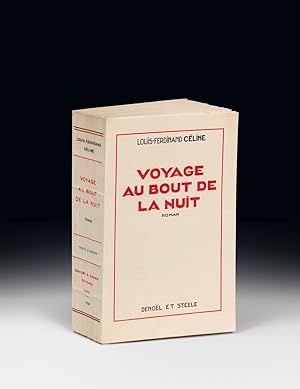
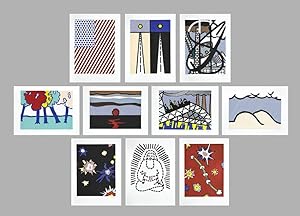
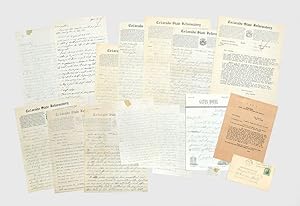
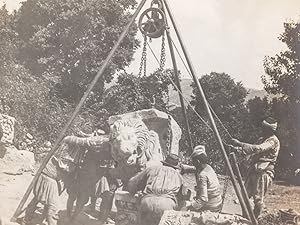
![Image du vendeur pour [La Divina Commedia / The Divine Comedy - Manoscritto dell'inizio del XX secolo della Divina Commedia di Dante - con strofe manoscritte da "L'Inferno / Inferno" - "Purgatorio" - "Il Paradiso / Paradiso"] - The Manuscript is titled: "Pictures Illustrating The Pilgrimage of the Divine Poet Through The Realms of Punishment of Penance and Peace" - Illuminated Devotional Manuscript of section of "L'Inferno / Inferno" - "Purgatorio" - "Il Paradiso / Paradiso" - with excerpts of Dante's Divina Comedia, in the style of medieval illuminated manuscripts. The manuscript is a strictly themed Dante Devotion and is of magical quality if one considers the fantastic, original calligraphy artwork, the composition of the manuscript and the coded meaning to the composer of this manuscript. The Folio - size manuscript is massive and has 216 pages, of which 109 pages are with illuminated, original watercolour-paintings in the style of the medieval masters, sometimes collages with watercolour and original e mis en vente par Inanna Rare Books Ltd.](https://pictures.abebooks.com/inventory/md/md30488476856.jpg)
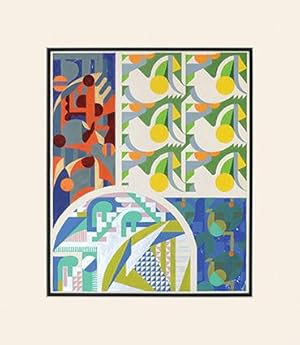
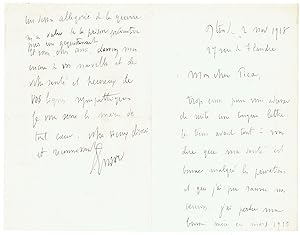
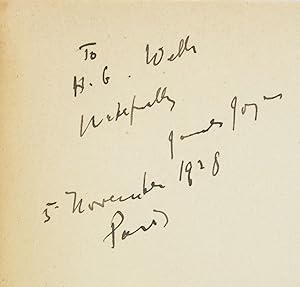
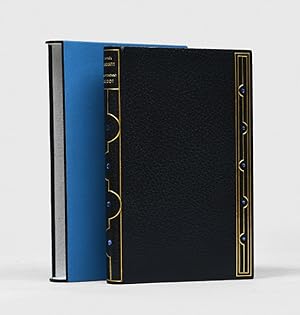
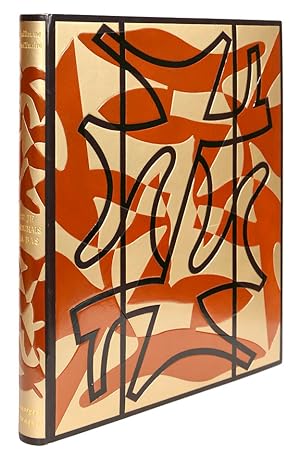
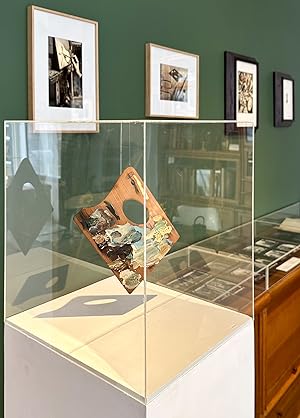
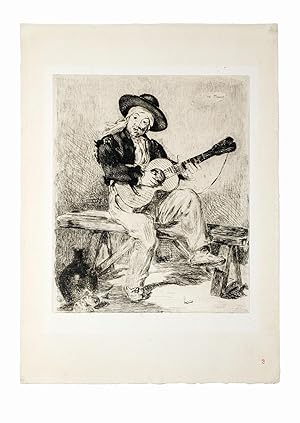

![Image du vendeur pour Ausgeführte Bauten und Entwürfe von Frank Lloyd Wright (Completed Building and Designs of Frank Lloyd Wright) [The Wasmuth Portfolio] mis en vente par Manhattan Rare Book Company, ABAA, ILAB](https://pictures.abebooks.com/inventory/md/md31098742133.jpg)
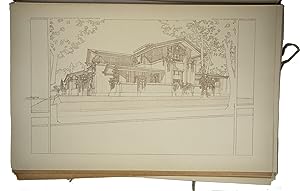
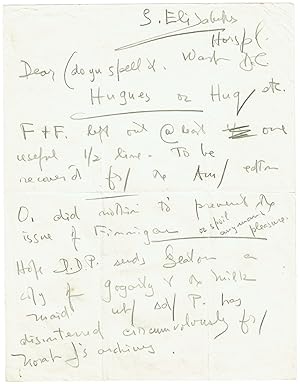
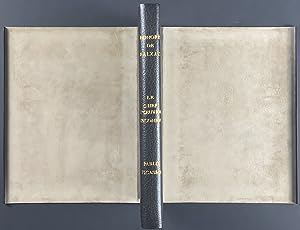
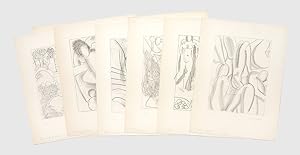
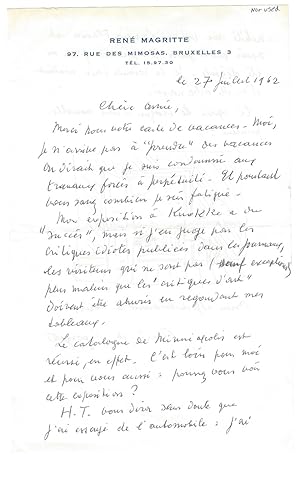
![Image du vendeur pour Eight Studies [for the Book of Genesis] mis en vente par James Cummins Bookseller, ABAA](https://pictures.abebooks.com/inventory/md/md31746952588.jpg)
